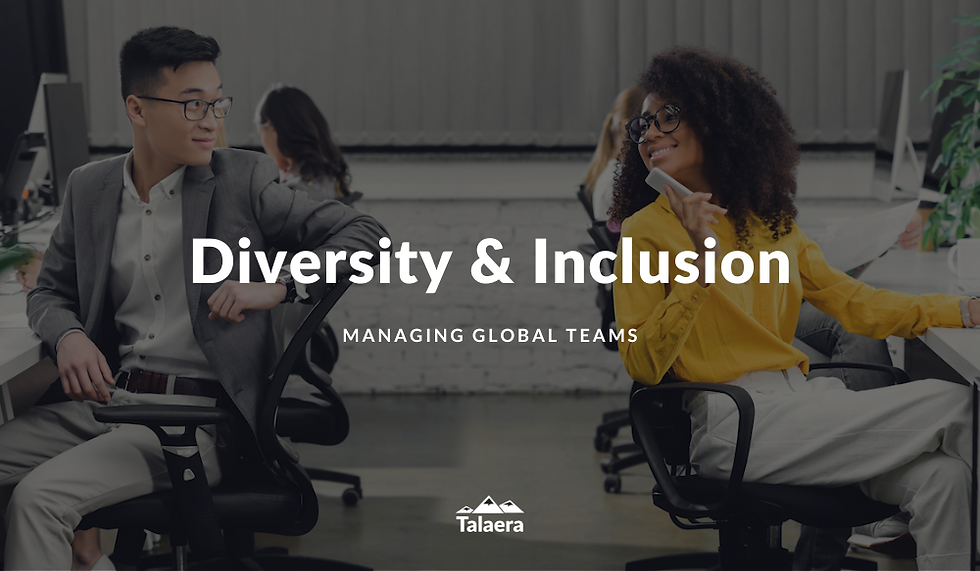
Diversity and inclusion, if managed correctly, provide a competitive advantage. Greater returns to shareholders, employee retention, and higher innovation revenues are some of the benefits of workplace diversity -and yet, according to Glassdoor, 57% of employees think their company should be doing more to increase diversity among its workforce.
Globalization in the workplace -expedited by a world pandemic- has opened up endless possibilities for recruiters, but it hasn’t come withohttps://www.talaera.com/blog/9-signs-of-cross-cultural-communication-challenges-in-your-teamut pitfalls. Diversity and inclusion is one of the top HR challenges in multinational companies. In this article, we will look at the main challenges of managing diversity and inclusion in the workplace, the benefits organizations get if managed correctly, and some directly applicable strategies you can start to implement to revamp your DEI strategy.
Download our free guide How to Manage Diversity and Inclusion in the Workplace, which includes a summary of the top strategies on diversity and inclusion and a guide on implementing inclusive language in your workplace.
What is diversity in the workplace?

Workplace diversity refers to organizations that deliberately employ people from different characteristics, such as gender, religion, race, age, ethnicity, culture, sexual orientation, language, physical abilities, or education. Diverse organizations have employees with a wide range of characteristics, experiences, and opinions.
Managing diversity effectively means that you understand and embrace that each individual is unique, you recognize their individual differences, and you praise them.
What is inclusion?

Inclusion in the workplace means that all the employees, regardless of all their differences (in terms of age, race, background, beliefs, or abilities) have the right to be respected and appreciated as any other member of the organization.
In an inclusive workplace culture, all the employees feel that they are valued and that they also add value to the organization. Without an inclusive, none of your diversity efforts will succeed. For that, you will need to educate staff and leaders, listen and communicate effectively, and implement effective strategies to build diversity and inclusion in the workplace.
Top 5 Challenges of Diversity in the Workplace
Managing people is usually challenging, but when those people come from all sorts of backgrounds and have different abilities and beliefs, those difficulties get tougher. In order to implement the right strategies to manage language and cultural diversity, it is important to understand the specific pitfalls you might encounter to then be able to tackle them properly.
1. Language barriers

Working in a multinational company comes with specific challenges for HR, and language barriers is one of the most prominent ones. Studies indicate that the vast majority of organizations struggle with language barriers in their day-to-day work, which means that the importance of managing language barriers has never been greater than today.
Lack of proficiency in English (or in your company language) can lead to damaging consequences both internally (among colleagues) and externally (in customer interactions). Language barriers in the workplace can not only cost time and cause frustration, but they also can also be the cause of 25% of job site accidents. Not fully understanding procedures, practices, and role requirements can lead to productivity loss, less efficiency, and higher turnover rates.
If your workforce’s language proficiency falls short, they risk having communication problems and unfair biases. In some environments, admitting that you do not understand is much more difficult than in others. When this happens, the result is not only misunderstood instructions and missed deadlines, but also embarrassing and tricky situations. This is why overcoming language barriers is essential to establishing an inclusive and diverse culture. Managers who recognize this notion understand that communications training is an effective way to close this language gap.
2. Misunderstandings

It might not even be a matter of language barriers, but also cultural differences. The words “yes” and “no” don’t necessarily have the same meaning in different countries (let alone in different languages!). The fact that your employees are able to speak English fluently doesn’t mean that they are able to fully grasp these nuances perfectly, and this can also mean that they might have a different understanding of authority, hierarchies, team work, or deadlines. Find out if your employees are struggling with cross-cultural communication in the workplace.
3. Workplace silos

Differences (in race, nationality, or language) are a strong bond between humans, and it is fine to take advantage of this. The danger comes when these groups segregate and you have a divided workforce.
A diverse workforce without proper support leads to organizational silos as employees with similar backgrounds tend to team up and isolate themselves. If you have groups of non-native English employees with a shared native language, chances are they more comfortable communicating among themselves. This can be dangerous, as it can result in lack of cohesion, duplicated work, and a poor knowledge-sharing environment.
Silos in the workplace can lead to frustration among those peers that can’t follow internal conversations, hamper growth, and missed opportunities. Plus, an organization can’t be agile and siloed at the same time. Yet only 19% of employees in the U.S. report that they’re satisfied with cooperation between their department and others, according to recent Gallup research. And a Slack Future of Work Study found that nearly one in four workers (24%) in the U.S. are dissatisfied with communication at work, including how information is shared.
The good news? There are best practices you can implement in your organization to break down workplace silos that will help you build and empower cross-functional teams.
4. Lack of trust

Trust is the glue holding organizations together, so it is crucial that you build a great company culture to help your workforce feel unified, integrated, and included. Without proper management and education, lack of trust stemming from diversity can result in international employees feeling left out (“I don’t belong here”), and in bias from local employees – some team members might perceive colleagues with lower language proficiency as “less competent” and are therefore less inclined to trust in their expertise, even when that is not the case.
5. Lack of confidence

If your employees feel less, you will get less. If your diverse workforce feel that they don’t belong, that they don’t have the necessary capabilities for a task, or they feel insecure speaking the company language (also known as language-based anxiety), they will be less likely to contribute and show initiative. If they lack confidence, your organization will miss out on their potentially awesome ideas!
Help your international workforce gain the confidence that they need to speak up at work. Invest in business English training and enable global employees to join the conversation.
What are the benefits of diversity and inclusion?
A diverse and inclusive environment creates a safe space for everyone to thrive and share ideas. The immense gains from adopting D&I strategies span from business results, innovation, and decision-making. Considering all the challenges mentioned above, good management of cultural and language diversity is central to setting your company up for success. Building up on these 4 tangible benefits of having an international workforce, here are the top advantages you will get:
Attract and retain top talent
It has been proven that more diverse workplaces have advantages when it comes to recruiting top talent. According to a survey conducted by Glassdoor, a diverse workplace is one of the main factors potential employees take into account when considering a job. Additionally, expanding your recruitment searches to more diverse candidates will widen your talent pool and increase your chances of finding the perfect candidate. Once you’ve hired these great fits, increase employee retention by making them feel included and part of your business family, which will also increase employee engagement and trust.
Boost innovation
With a diverse workforce, organizations get new perspectives and a much higher chance of coming up with new, great ideas. Harvard Business Review found that diversity is a driver of innovation and performance – “indeed there was a statistically significant relationship between diversity and innovation outcomes in all countries examined”.
Improve productivity, performance, and business results
Racially and ethnically diverse companies are 35% more likely to outperform competitors. Empirical evidence suggests that there are significant positive effects of cultural diversity on productivity and revenues for culturally diverse high-skilled workers. The different skills and experience, together with problem-solving approaches and cultural-specific knowledge give organizations a significant competitive advantage.
Save (and make) money with excellent communication skills
An international workforce where your employees speak different languages will help you with business – reaching new clients and opening up new markets. However, it is important that they feel perfectly comfortable in English as well (if this is your company language).
Including communications training in your diversity and inclusion strategy will save you money. According to a Holmes report, the cost of poor communication amounts to an overwhelming $37 billion. Conversely, “companies that have leaders who are highly effective communicators had 47% higher total returns to shareholders over the last five years compared with firms that have leaders who are the least effective communicators.” Your organization will experience the best results and highest levels of productivity when communication channels are streamlined and everybody understands exactly where they stand and what they have to do. Offering communications training to your international employees will streamline communication across teams and avoid misunderstandings, for your sales teams to master negotiations in English, and for your customer success to strengthen relationships with customers, if that is your corporate language.
Strategies for Managing Diversity in the Workplace
If you’ve come this far, you’re probably wondering – what can I do today to manage diversity and inclusion in my organization? Knowing that you need a diverse workforce is step one, but the real benefits are only possible if you understand the details of managing it in your organization. HR professionals and leaders often apply the same management style for all the employees within their organization, regardless of the individual and their needs.
The key to managing diversity in the workplace is adjusting your leadership style to each person and situation. All the benefits of a diverse workforce together with leaders who appreciate and leverage all those differences and capabilities result in well-managed, happy, and high-performing teams.
You can read all the strategies in our guide How to Manage Diversity and Inclusion in the Workplace, together with a guide on implementing inclusive language in your workplace.
1. Build trust and communicate with your employees

Create an environment where everyone can feel comfortable bringing their true and best selves to work and value their differences. To provide workers with a safe space to voice their concerns, communicate frequently and openly.
Creating a trusting environment is key to welcoming employees and making them feel at home in the workplace. Offer support, be sensitive towards other cultures, and send frequent follow-ups and reminders. Facilitate communication by being consistent.
We interviewed Lior Lavi, a Software Development Manager at SAP with over 15 years of experience in the high-tech industry and management. He shared excellent advice on how managers can build trust in the workplace and increase employee engageent.
An effective strategy to increase trust in a diverse workplace is to adopt a common corporate language that all the employees are aware of and know well. This consistency will increase the chances of implementing effective communication within the organization. Use simple terms and expressions, avoid idioms, jargon, and slang words, and implement visual methods of communication (like pictures in manuals, signs or cue cards). Simplify instructions in general, and use both telling and showing methods. This is not a recommendation for talking down. Conversely, just introduce effective messaging tools and deliver your message intelligently. If your employee’s communication skills are not proficient, there is no need to talk louder, just speak correct, standard English, slowly and clearly.
Other great ideas to build trust and feelings of belonging in remote teams are organizing team building diversity days, holding workshops on language-related emotion management, and training them on perception to help your employees perceive language barriers as less threatening.
2. Invest in language training
Your international employees may have a lot to say, but perhaps they lack the confidence and tools to do it in English. Access to professional English training helps international employees feel more confident at work, and they also feel that their employers and HR managers truly care about their professional development.
Plus, one of the main motivators of top performers is continuous learning. Enable your global teams to join the conversation by offering them learning opportunities to grow and develop their communication skills.
Wayne Applehans, president and Chief Product Officer of Jones/NCTI, recommends to “opt for training that is personal, relevant and that uses the best technology for your employees.” According to a Jones/NCTI study, one-on-one mentoring is one of the preferred types of learning; “80% of respondents across generations say it’s important or very important that their company provides training options to fit their learning styles.” For most respondents, having training and development opportunities influence their decision to stay with the company; and last but not least, “they all want more opportunities to learn on the job,” which involves the technology available to actually take part in these training opportunities.
At Talaera, we offer business English training tailored to individuals and teams. Based on your organization’s needs, we can create a scalable English training program with one-on-one sessions, group courses, workshops, and webinars.
Learn more about Talaera’s communications training
3. Educate your workforce (and yourself!)

Cultural and linguistic biases damage your organization. They make it very difficult for us to communicate effectively in global settings and hinder teamwork.
Apart from helping your non-native English speakers find their voice, train your global teams on cross-cultural competencies and help them increase their CQ (Cultural Intelligence). Start by learning, as an organization, how to ask better questions in cross-cultural workplaces and join communication webinars where you and your teams can learn how to better work across cultures.
You may also learn about different communication styles in different cultures. Listen to our culture series on our podcast, Talaera Talks, and learn how to communicate effectively with people from different cultures:
India
Germany
Israel
United States
“As HR practitioners, we take for granted when we say to leaders that they need to be inclusive that they know what we mean.” -Dianne Campbell
Your managers and executives play a pivotal role in all your D&I efforts, as they are on the front line with your employees. Good leaders understand what it takes to successfully manage cross-border teams. Educate them on what diversity and inclusion really mean. Help them understand that it is about ensuring that everyone’s opinions are considered, and that inclusivity is a core competency. Help them overcome biases and develop skills such as active listening, encouraging collaboration, and championing your company culture, and establish clear diversity policies that everyone lives by.
4. Provide employees with the necessary support and resources

How well do you know your people? Don’t assume that your employees know or understand the full picture. Be certain of your staff’s fluency and understanding levels and, especially at the beginning (although it can become a good habit), seek clarification and have the employee demonstrate their understanding (always being sensitive and courteous!).
Take time to learn about the different cultural norms and encourage other employees to learn about it too. Faraway cultures can have completely different ways of understanding the world, but sometimes even neighbor nations differ from each other. Find out about their language, power perception, and customs but also do not assume that this is exactly how your employee will be.
Once you identify underrepresented groups’ needs, make sure you give your workforce the necessary support and resources they need to thrive – not only for those underrepresented employees but also for everyone else (for example, by providing useful articles on how to cultivate workplace inclusion for blind employees, if relevant).
5. Hold more effective meetings – for everyone

Everyday activities will have a bigger impact on how included your employees feel than anything else. Meetings are a great place to start. Some cultures are more assertive and direct. Those tend to find it easier to speak up, while others find it hard to say no or disagree.
Encourage contributions from everyone by distributing meeting materials in advance and share potential questions to be discussed, make sure everyone has access to the right technology for their role and needs, rotate meeting times if you have remote workers in different time zones, be conscious of different communication styles, and promote active debates where everyone is heard.
If you are a leader managing diverse teams, you can also watch our webinar Managing Across Cultures on demand.
6. Review your corporate communication to eliminate unconscious bias

Are you mindful of all you unconscious biases? Awareness is the first step. Test yourself and spread understanding across your organization.
Make sure that all your corporate communications represent your diverse and inclusive culture. Review all your communication materials (job descriptions, website copy, brochures, etc.) and remove unconscious bias. Include clear guidelines on your company’s style guide on how to communicate diversity and inclusion.
In today’s increasingly diverse and globalized world, it is paramount that we employ inclusive language in order to comprehensively accommodate and include our colleagues of different genders, sexual orientations, races, and abilities. Not only does inclusive language enhance the mental and emotional well-being of existing employees, but it may also help to ensure all potential clients, partners, and new hires feel welcome, seen, and respected.
Encourage employees and managers to use gender-neutral and affirmative language (download our diversity and inclusion guide for free and read about adopting non-biased, affirmative language).
Build Your Team Based On Inclusive And Effective Communication
Enable your global employees to join the conversation. Level up the playing field by equipping your international teams with the communication tools they need to thrive in today’s workplace. At Talaera, we help your non-native English speakers communicate effectively in the workplace. With personalized and scalable business English programs, our experience instructors work with learners on real-life challenges. Request more information here.
For any additional information or questions, you can also reach out at hello@talaera.com. Interested in getting the best offers and receiving free content on Business English communication? Subscribe to our newsletter and we will keep you in the loop with offers, free events, and development materials!
If you enjoyed this article, keep reading:
[Originally posted on Sept 16, 2019 recently updated.]



